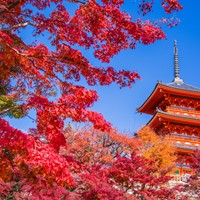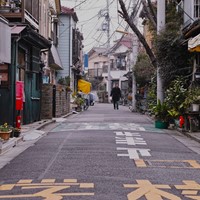5 Reasons to Visit Kyoto in Winter

This article is related to Four Seasons Hotel Kyoto. We are pleased to provide Four Seasons Hotel guests with special benefits. Before making a reservation, please contact us for further information.
Discover Kyoto's hidden gems in winter, the city's magnificent but lesser-known season, which locals adore. Here are 5 favorite Kyoto winter warmers, as selected by the experts at Four Seasons Hotel Kyoto: mesmerizing illuminations in gorgeous temples to seasonal meals brimming with flavor; exuberant New Year celebrations to "onsen" hot springs amid snow-capped mountains.
There are also many articles covering travel destinations in Japan including superb sakura spots in Kyoto, best places to see autumn leaves in Japan, ski resorts near Tokyo, a coastal city of Atami, Kamakura, Nikko, and more.
>> Learn about a great Japan Rail Pass
1. Japanese Plum Blossoms (Ume)

Despite the fact that spring is the most well-known season for blossoms in Japan, winter visitors will be pleasantly surprised by Kyoto's abundance of delicate ume (plum) flowers. The delicious scent and pretty five-petaled arrangement of ume blossoms, which adorned the city's plum trees in colours of snow white to lush pink, inspired ancient aristocrats from the Nara period (AD 710–784) to write haiku while gazing at them.
Ume blossom's delicious scent and attractive five-petaled composition encouraged ancient aristocracy from the Nara period (AD 710–784) to write haiku while staring at them, which were decorating the city's plum trees in colours of snow white through to lush pink.
From mid-January, blooming plum trees can be seen all across Kyoto, formerly a source of wealthy trade with China and now prized for their particular beauty. Kitano Tenmangu has some of the nicest views, with 1,500 plum trees blooming from mid-March to the end of April.
2. Winter Warming Dishes
Kaburamushi
The Japanese have traditionally tailored their food to the country's four distinct seasons, and winter is no exception. Try Kaburamushi, a fragrant combination of grated turnip, egg white, lily root, gingko, and mushrooms over a white fish that looks like a melting snowball to locals.

Yudofu
Warm up from the inside out with Kyoto's extensive selection of steaming hot pots and sizzling Yudofu.

Steamed Sushi (Mushi-zushi)
Steamed Sushi is a hot meal with a special taste that originated in Kyoto, whereas Tanuki Udon uses the spicy warmth of ginger on a base of chopped fried tofu with thick ankake sauce.
Zenzai (Mochi)
Zenzai, a tiny chewy rice delicacy offered in tea houses and traditional cafes across Kyoto, is a festive favorite during the new year.

3. Illuminations that Inspire

Kyoto comes alive with glittering lights as the sun sets low over the chilly horizon.
Lanterns at Kifune Shrine
Lanterns are only lit on snowy days at Kifune Jinja Shrine from January to February, making seeing the shrine's lovely crimson steps and tree boughs aglow a rare yet wonderful experience.
Kayabuki-no Sato
Marvel at the highland heritage site of Kayabuki-no Sato as the entire hamlet of thatched dwellings becomes festive with handmade snow lanterns, food stalls, dance performances, and cultural events ranging from mochi pounding to traditional craftsmanship from the end of January for a week.
4. Indulge yourself in Kyoto's Bathing Culture

Bathing is an important component of Japanese culture, as it is a daily practice of purification and enjoyment.
Sento
Bathing has traditionally been seen as a social activity, with locals coming to the city's "sento," or public baths, to mingle. In Kyoto, there are just a few spectacular sentos, such as the art-filled Funaoka Onsen Sento and the scorching hot sauna at Goko-yu Sento, which is perfect after a long hike.
To avoid the winter chill, take a relaxing bath in one of the city's "onsen," or natural hot springs. The hotel is 40 minutes away from Kurama Onsen, which offers a great experience of being surrounded by forested mountains, and Arashiyama Onsen, which is only 30 minutes away and offers views of Arashiyama.
Guests of the Four Seasons Hotel Kyoto can enjoy a complimentary relaxing "ofuro" hot bath and sauna on the hotel's wellness floor, B2, as well as at THE SPA.
5. Winter Activities Only Available During The Season

Make this winter a season of discovery in a country filled with regional delights.
Fushimi, a sake-brewing district fed by the clear, clean water of the Horikawa river, is a great place to start your winter Kyoto adventure. The brewers create fresh sake from newly harvested Fall rice from December to January and offer sake tastings, which are great for warming the body on a cold day. Request that our Concierge locate and book the best sake breweries in Kyoto (there are 50 in total, including 19 in Fushimi!) for your visit.
Amazing geologic structures covered in snow beside massive boulders, glimpses of the surrounding mountains, enigmatic deep pools, and local flora and animals may all be seen from the comfort of a heated boat on the Hozu-gawa river in the winter.
The annual 'Kyo no fuyu no tabi' (means Kyoto Winter Trip) exhibition, which has been held at fifteen different city temples for more than 50 years, showcases the magnificence of rare Japanese art. It's a once-in-a-lifetime opportunity to see the secret riches of each temple, which are usually hidden from public view. The museum is open from mid-January until mid-March.
Enjoy your Stay at Four Seasons Hotel in Kyoto
As it is stated above. we provide special benefits of Four Seasons Hotel. If you are planning to make a reservation, please contact us before making a reservation for further information.
Tours in Kyoto
If you would like to take Kyoto tours in English, Japan Wonder Travel offers group and private ones.



















